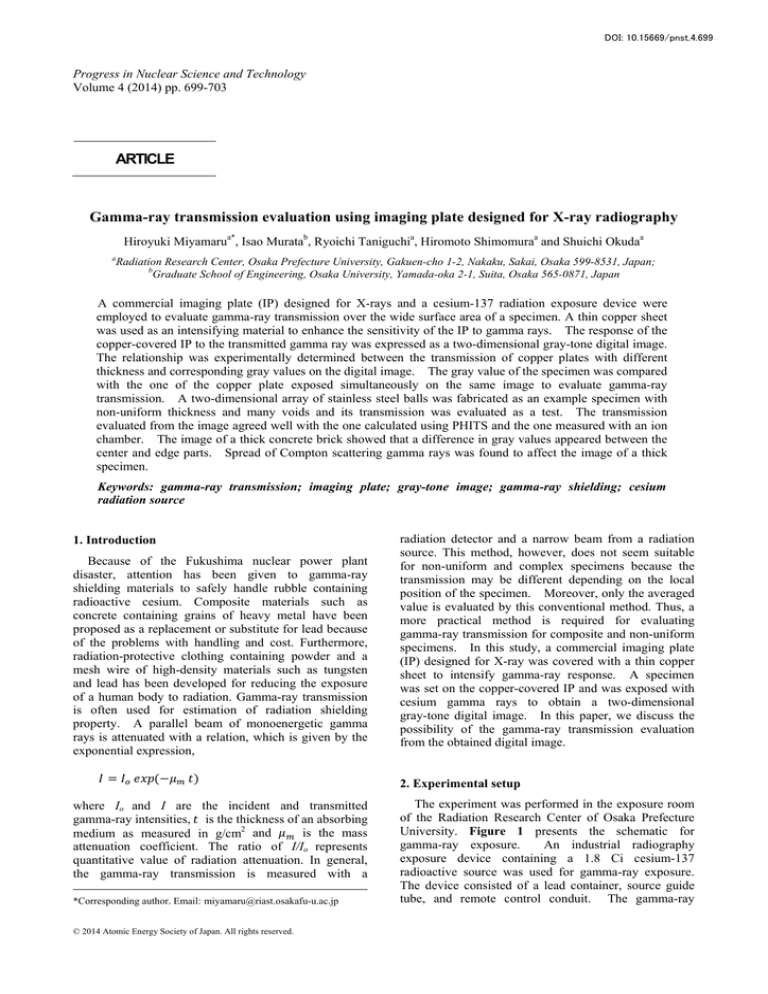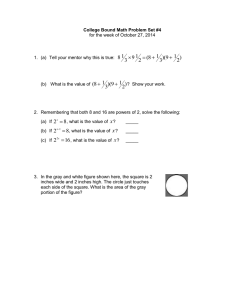
DOI: 10.15669/pnst.4.699
Progress in Nuclear Science and Technology
Volume 4 (2014) pp. 699-703
ARTICLE
Gamma-ray transmission evaluation using imaging plate designed for X-ray radiography
Hiroyuki Miyamarua*, Isao Muratab, Ryoichi Taniguchia, Hiromoto Shimomuraa and Shuichi Okudaa
a
Radiation Research Center, Osaka Prefecture University, Gakuen-cho 1-2, Nakaku, Sakai, Osaka 599-8531, Japan;
b
Graduate School of Engineering, Osaka University, Yamada-oka 2-1, Suita, Osaka 565-0871, Japan
A commercial imaging plate (IP) designed for X-rays and a cesium-137 radiation exposure device were
employed to evaluate gamma-ray transmission over the wide surface area of a specimen. A thin copper sheet
was used as an intensifying material to enhance the sensitivity of the IP to gamma rays. The response of the
copper-covered IP to the transmitted gamma ray was expressed as a two-dimensional gray-tone digital image.
The relationship was experimentally determined between the transmission of copper plates with different
thickness and corresponding gray values on the digital image. The gray value of the specimen was compared
with the one of the copper plate exposed simultaneously on the same image to evaluate gamma-ray
transmission. A two-dimensional array of stainless steel balls was fabricated as an example specimen with
non-uniform thickness and many voids and its transmission was evaluated as a test. The transmission
evaluated from the image agreed well with the one calculated using PHITS and the one measured with an ion
chamber. The image of a thick concrete brick showed that a difference in gray values appeared between the
center and edge parts. Spread of Compton scattering gamma rays was found to affect the image of a thick
specimen.
Keywords: gamma-ray transmission; imaging plate; gray-tone image; gamma-ray shielding; cesium
radiation source
1. Introduction1
Because of the Fukushima nuclear power plant
disaster, attention has been given to gamma-ray
shielding materials to safely handle rubble containing
radioactive cesium. Composite materials such as
concrete containing grains of heavy metal have been
proposed as a replacement or substitute for lead because
of the problems with handling and cost. Furthermore,
radiation-protective clothing containing powder and a
mesh wire of high-density materials such as tungsten
and lead has been developed for reducing the exposure
of a human body to radiation. Gamma-ray transmission
is often used for estimation of radiation shielding
property. A parallel beam of monoenergetic gamma
rays is attenuated with a relation, which is given by the
exponential expression,
=
(−
)
where Io and I are the incident and transmitted
gamma-ray intensities, is the thickness of an absorbing
is the mass
medium as measured in g/cm2 and
attenuation coefficient. The ratio of I/Io represents
quantitative value of radiation attenuation. In general,
the gamma-ray transmission is measured with a
*Corresponding author. Email: miyamaru@riast.osakafu-u.ac.jp
© 2014 Atomic Energy Society of Japan. All rights reserved.
radiation detector and a narrow beam from a radiation
source. This method, however, does not seem suitable
for non-uniform and complex specimens because the
transmission may be different depending on the local
position of the specimen. Moreover, only the averaged
value is evaluated by this conventional method. Thus, a
more practical method is required for evaluating
gamma-ray transmission for composite and non-uniform
specimens. In this study, a commercial imaging plate
(IP) designed for X-ray was covered with a thin copper
sheet to intensify gamma-ray response. A specimen
was set on the copper-covered IP and was exposed with
cesium gamma rays to obtain a two-dimensional
gray-tone digital image. In this paper, we discuss the
possibility of the gamma-ray transmission evaluation
from the obtained digital image.
2. Experimental setup
The experiment was performed in the exposure room
of the Radiation Research Center of Osaka Prefecture
University. Figure 1 presents the schematic for
gamma-ray exposure.
An industrial radiography
exposure device containing a 1.8 Ci cesium-137
radioactive source was used for gamma-ray exposure.
The device consisted of a lead container, source guide
tube, and remote control conduit. The gamma-ray
700
H. Miyamaru et al.
source was introduced to the head of the guide tube via a
manual crank-out mechanism. A source position
corresponding to the exposure working position was set
about 1 m above ground level. A measurement
specimen was set 80 cm below the source position.
The CR ST-VI imaging plate (Fuji), which is a
commercial product for X-ray radiography [1,2], was
used for the experiment. The IP covered with a
0.3-mm-thick copper sheet was set below the specimen.
The role of the copper sheet is described later. The ion
chamber (VICTOREEN 550-3-T) was set below the IP
with a lead aperture 30 mm in diameter to measure the
gamma-ray transmission of a local area of the specimen.
After gamma-ray exposure, the IP was brought to a
readout unit (FUJI AC-7/ST) and processed to form a
gray-tone computed radiography (CR) image. The
dimensions of the IP were 20 cm × 25 cm, and one pixel
was 0.1 mm2. Output images were subsequently
processed using the ImageJ 1.45s software for
evaluating the gamma-ray transmission. All images
were processed using a neighborhood mean filter (4
pixels) for smoothing and were converted into 8-bit
gray-tone images. The dose for exposure was low so
that no afterimage was left behind on the IP. The IP
was used repeatedly after the readout procedure.
Figure 1. Experimental setup for gamma-ray transmission
measurement using IP.
3. Experimentals
thin metal sheet on the IP for increasing the sensitivity to
high-energy gamma rays is similar to that of studies
using a metal plate/phosphor screen [3,4]. As with
previous studies, the thin copper sheet possibly acts as
an intensifying material that converts a gamma ray into
X-rays and electrons.
Figure 2. Gray-tone digital image of the IP exposed to cesium
gamma rays. Right side is covered with a thin copper sheet
during exposure. The images of lead plates with different
thicknesses are shown as three rectangles on the boundary.
The response of the generated X-rays and electrons
was recorded on the IP; consequently, the response of
the IP covered with the copper sheet shows much higher
sensitivity than that of bare IP. The images of the lead
plates on the copper-covered side were compared; the
lead plate with 1mm thick shows deep gray and the one
with 3mm thick is rather bright. This result suggests that
the IP shows different gray color in accordance with the
transmission characteristic of a gamma-ray exposed
specimen. The relation between gamma-ray transmission
and the response of the copper-covered IP is examined
experimentally in a following subchapter. Fading effect
of the image was not observed in our study. This
transmission image using the copper-covered IP and
gamma-ray exposure is completely reproducible. To
intensify the sensitivity, the 0.3mm-thick copper sheet
was always placed in front of the IP throughout our
study.
3.1. Gamma-ray response of IP
Figure 2 shows the response of the IP exposed to a
dose of 15 Gy as a gray-tone digital image. The right
half of the image corresponds to the part of the IP
covered with a 0.3-mm-thick copper sheet before
exposure, and the left half shows the bare IP surface.
Images of the lead plates with different thicknesses are
shown as three rectangles. The gray value at each pixel
corresponds to the intensity of the radiation response.
The left part displayed in light gray corresponds to the
area that did not respond to the gamma rays; in contrast,
the deep dark color at the covered part indicates a more
intense response. Since the copper sheet was thin, the
exposure intensity to cesium gamma rays at each part
was expected to be almost the same value. Nevertheless,
covering the IP with a copper sheet produced a higher
response against gamma rays. Our method of using a
3.2. Relationship between gray value and gamma-ray
transmission
Figure 3 shows the gray-tone image of copper plates
with 2–8 mm thickness. The difference in thickness is
clearly expressed by the relative differences in the
gray-tone color of a single image. In order to clarify
the relationship between the gray value and the thickness
of copper, the representative gray value of each copper
plate was determined through the following procedure.
A region-of-interest (ROI) that was 2 cm2 was selected
from the image of the plate, and a histogram was
calculated from the distribution of gray values in the
selected ROI. The mean gray value of the histogram
was finally taken as the representative gray value of the
copper plate for a specific thickness. For dense materials
like the copper plate, the histogram showed a
701
Progress in Nuclear Science and Technology, Volume 4, 2014
symmetrical shape, as shown in the figure; however,
specimens that include voids show complicated shapes
as demonstrated later.
Figure 5 shows the relationship between thickness of
copper and mean gray values taken in our study. The
uncertainty was the standard deviation of the gray value
in the histogram. The relationship shows a linear
dependency. The transmission of cesium gamma ray
for individual thickness is calculated with above denoted
equation and mass attenuation coefficient of the XCOM
data [5]. From the calculation result, the copper
thickness of 2-15 mm corresponds to the range from
0.88 to 0.38 of transmission. Experimental result
clearly indicates that the evaluated mean gray value has
linear dependency with the gamma-ray transmission.
120
Figure 3. Gray-tone digital image of copper plates with
different thicknesses.
The histogram at right bottom
represents the distribution of the gray values in the dashed
area.
Mean gray value (arb)
100
80
60
40
The gray value employed here is not an absolute value
but is relative. Although the gray value can be adjusted
using software as a digital image, relative relation of the
gray value at each position in one image can be
maintained. In every exposure, several copper plates
with known thickness were simultaneously exposed with
a target specimen. The gray values of copper plates were
used as reference to evaluate the gamma ray
transmission in each specimen position of a single image.
Mean gray values of the IP are plotted versus exposure
dose in Figure 4. These values were taken in the
exposure condition using the copper-covered IP. These
values were evaluated from the IP area without a
specimen. The response of the IP used here showed
linear dependency with gamma-ray dose in the range we
employed for exposure.
160
150
Mean gray value (arb)
140
130
120
110
100
90
80
8
12
16
20
24
Dose ( μGy)
Figure 4. Relationship between mean gray value and
gamma-ray dose for exposure. The uncertainty is standard
deviation of the gray value in the histogram.
20
0
5
10
15
20
Thickness (mm)
Figure 5. Relationship between mean gray value and thickness
of copper. The uncertainty is standard deviation of the gray
value in the histogram.
3.3. Two-dimensional stainless steel ball array
A two-dimensional array of stainless steel balls was
fabricated as an example specimen with non-uniform
thickness and many voids, and its gamma-ray
transmission was evaluated from the image. Figure
6(a) shows the gray-tone image of the ball array, and
Figure 6(b) shows the three-dimensional image of the
selected region. The gray scale of 3-D image is adjusted
manually for appearance. Stainless steel balls with1.27
cm diameters were aligned two-dimensionally in a
plastic cage, and two copper plates that were 3- and 7–
mm-thick were positioned besides the array for
comparison. In the two-dimensional image, the shape
of the array can be clearly identified, but the distribution
of the gray value inside a single ball is unclear. The gap
between the balls corresponds to the voids and is
expressed with a deep gray color. The histogram in
Figure 6(a) was calculated from the gray values in the
dotted circle of the image. The dotted circle was selected
as a ROI, and the gamma-ray transmission at this region
was evaluated. The obtained histogram does not show a
symmetrical single peak like the copper plate above but
shows two peaks: the primary peak at the light gray-tone
side is due to the balls, and the secondary one is due to
the voids.
702
H. Miyamaru et al.
with different conditions in which the gamma-ray beam
positions against the ball array are slightly changed.
Although the uncertainty range is somewhat wide, the
transmission evaluated from the image agreed well with
both the calculated and measured results.
3-D view area
Table 1.
7mmt
Evaluated transmission value of the ball array.
IP
Ion chamber
Calculation
70±12%
69±4%
70.0±1.5%
3mmt
3.4. Image of concrete brick
Figure 6. (a) Gray-tone digital image of stainless steel ball
array. The gamma-ray transmission at the dashed circle area
was evaluated. The histogram in the figure represents the
distribution of the gray values of the target area.
Figure 6. (b) Three-dimensional gray-tone image of the ball
array. Corresponding area is the dashed rectangle in Fig. 6(a).
In order to evaluate the gamma-ray transmission at the
ROI, the integrated value of the gray values over the
histogram was employed as a representative value
instead of the averaged gray value in this case. The
ROI with the same size was specified for the individual
copper plate, and the integrated value was calculated in
the same manner. The integrated gray value of the ball
array was compared with those of the copper plates and
corresponding thickness of copper was estimated. The
gamma-ray transmission of the ball array was finally
evaluated from the calculation with corresponding
thickness.
The transmission at the ROI was
experimentally measured using the ion chamber. A
Monte Carlo simulation of the gamma-ray transmission
was performed using PHITS [6] under the calculation
conditions including the same structure of the ball array.
Table 1 summarizes the results of the transmission of
the ball array. The uncertainty of the transmission
evaluated from the IP was evaluated from the standard
deviation of the integrated gray value. The uncertainty
in the calculation is the deviation of the tallies calculated
The gray-tone image of a flat concrete brick was
obtained as an example of a large and thick specimen.
The brick was homogeneous, and its thickness was also
uniform. The dimensions of the brick were 20 cm × 10
cm × 4 cm, and the density was 2.2 g/cm3. Figure 7
shows the gray-tone and three-dimensional images of
the concrete brick. The change in the gray value can be
Figure 7. (a) Gray-tone digital image of the concrete brick. (b)
Three-dimensional image.
observed; the color of the center part is a deeper gray
rather than that of the edge.
The gamma-ray
transmission as measured with the ion chamber was
about 56%, and this was the same for the entire surface
area of the brick. In the image, the gray value of the
edge part corresponded to the correct value, but the
value at the center part indicated a large increase in
transmission. The obtained image shows disagreement
with the gamma-ray transmission property of the brick.
Presence of deep gray at the center part can be explained
due to Compton scattering gamma rays generated in the
brick. Angular spread of the scattering gamma ray
exposes the pixel locating far from the initial interaction
position. Consequently, the overlap of this exposure
becomes remarkable at the center part. We found that
the influence of scattering gamma rays should be taken
into account in evaluating the transmission correctly for
a thick specimen.
Progress in Nuclear Science and Technology, Volume 4, 2014
4. Conclusion
In our study, we employed a commercial X-ray
imaging plate covered with a thin copper plate to
establish a practical method for evaluating the cesium
gamma-ray transmission of various materials. The
transmission of the ball array as evaluated from the
image agreed well with both the experimental and
simulation results. The gray-tone image of the thick
concrete brick showed different gray values at the edge
and center parts, resulting in the influence of scattering
gamma rays. Our evaluation method is currently not
suitable for a thick specimen. Appropriate correction
of the image for a thick specimen is currently under
investigation. Further study is in progress to establish a
practical evaluation method for gamma-ray transmission
using an imaging plate.
References
[1] M. Sonoda, M. Takano, J. Miyahara and H. Kato,
Computed radiography utilizing scanning laser
stimulated luminescence, Radiology 148 (1983), pp.
833-838.
703
[2] K. Takahashi, Progress in science and technology
on photostimulable BaFX:Eu2+ (X=Cl, Br, I) and
imaging plates, J. Luminescence, 100 1-4 (2002),
pp. 307-315.
[3] D. S. O’Keeffe and R. W. McLeod, Computed
radiography as a gamma ray detector-dose response
and applications, Physics in Medicine and Biology
49 (16) (2004), pp. 3559-3572.
[4] S. Taniguchi, A. Yamadera, T. Nakamura and A.
Fukumura, Measurement of radiation tracks for
particle and energy identification by using imaging
plate, Nucl. Instr. and Meth. in Phys. Res. A 413
(1998), pp. 119-126.
[5] L. Gerward, N. Guilbert, K. B. Jensen and H.
Levring, X-ray absorption in matter, Reengineering
XCOM, Radiation Physics and Chemistory 60
(1-2) (2001), pp. 23-24.
[6] K. Niita, N. Matsuda, Y. Iwamoto, H. Iwase, T.
Sato, H. Nakashima, Y. Sakamoto and L. Sihver,
PHITS: Particle and Heavy Ion Transport Code
System, Version 2.23, JAEA-Data/Code 2010-022
(2010).



![-----Original Message----- From: David Gray [ ]](http://s2.studylib.net/store/data/015586576_1-4303325ffa4fd11314fa07f2680bed65-300x300.png)